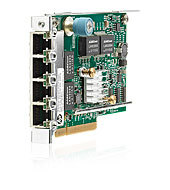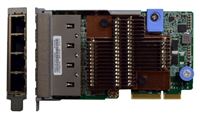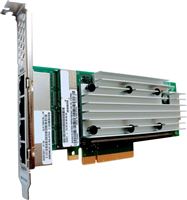2677 -- -- -- -- 2425 

HPE ADP 331FLR ETHERNET 1GB 4-PORT more
HPE ADP 331FLR ETHERNET 1GB 4-PORT
Single-chip, quad-port, 1Gb Ethernet Flexible LOM designed for maximum throughput and high port density. The HP Ethernet 1Gb 4-port 331FLR Adapter for select HP ProLiant Gen8 rack servers features the next generation of Ethernet integration, offering a single-chip solution in a Flexible LOM form factor, which offers the option for future upgrades to 10GbE networking speeds. It delivers full line-rate performance across all ports with low power consumption. The HP 331FLR is ideal for virtualization, security, server consolidation, network segmentation, and other applications requiring maximum throughput and port density. The total aggregate throughput of 4Gb meets the needs of customers desiring high bandwidth. The HP 331FLR supports advanced features such as Large Send and Receive offload capability, TCP checksum and segmentation, VLAN tagging, MSI-X, jumbo frames, IEEE 1588, HP Sea of Sensors 3D and virtualization features such as VMware NetQueue and Microsoft VMQ. Support for HP Sea of Sensors 3D Technology enhances server performance while reducing energy use and expense. The HP 331FLR Flexible LOM is designed for maximum throughput and high port density. Replaceable FLexibleLOM enables easy upgrade from 1GbE to 10GbE. An aggregate, full duplex transfer rate of 8 Gbps per adapter delivers outstanding network performance that improves response time and removes bottlenecks. Comprehensive stateless offloads optimize host efficiency and VM density by leaving host CPU available for other duties. Virtualization support for VMware NetQueue and Microsoft VMQ help meet the performance demands of consolidated virtual workloads. Support for MSI/MSI-X provides performance benefits for multi-core servers by load balancing interrupts between CPUs/cores.
Single-chip, quad-port, 1Gb Ethernet Flexible LOM designed for maximum throughput and high port density. The HP Ethernet 1Gb 4-port 331FLR Adapter for select HP ProLiant Gen8 rack servers features the next generation of Ethernet integration, offering a single-chip solution in a Flexible LOM form factor, which offers the option for future upgrades to 10GbE networking speeds. It delivers full line-rate performance across all ports with low power consumption. The HP 331FLR is ideal for virtualization, security, server consolidation, network segmentation, and other applications requiring maximum throughput and port density. The total aggregate throughput of 4Gb meets the needs of customers desiring high bandwidth. The HP 331FLR supports advanced features such as Large Send and Receive offload capability, TCP checksum and segmentation, VLAN tagging, MSI-X, jumbo frames, IEEE 1588, HP Sea of Sensors 3D and virtualization features such as VMware NetQueue and Microsoft VMQ. Support for HP Sea of Sensors 3D Technology enhances server performance while reducing energy use and expense. The HP 331FLR Flexible LOM is designed for maximum throughput and high port density. Replaceable FLexibleLOM enables easy upgrade from 1GbE to 10GbE. An aggregate, full duplex transfer rate of 8 Gbps per adapter delivers outstanding network performance that improves response time and removes bottlenecks. Comprehensive stateless offloads optimize host efficiency and VM density by leaving host CPU available for other duties. Virtualization support for VMware NetQueue and Microsoft VMQ help meet the performance demands of consolidated virtual workloads. Support for MSI/MSI-X provides performance benefits for multi-core servers by load balancing interrupts between CPUs/cores.
| Name | Hewlett Packard Enterprise |
| Street | Herrenberger Str. 140 |
| Zip code | 71034 |
| City | Böblingen |
| Phone | +49 69 153253561 |
| E-mail/Contact form | enterprise.kunden@hpe.com |
| Website | www.hpe.de |






